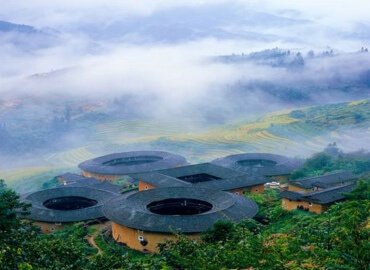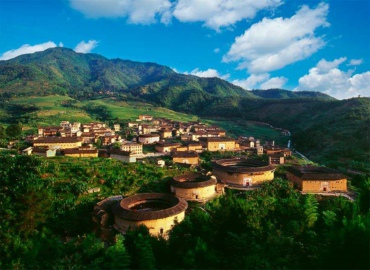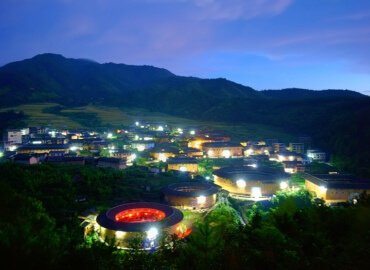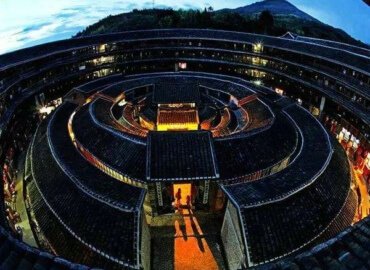Tulou
Tulou Overview
Fujian Tulou, also known as the Hakka Earth Building because most of it was built by Fujian Hakka people. It is featured as “Living World Heritage” and Cluster of Hakka Culture. The Fujian Tulou is the most extraordinary type of Chinese rural dwellings.

Hot
- 9 hours
One day tour to Tianluokeng Tulou Clusters from Xiamen
Visit the masterpiece of traditional Chinese residential buildings in Nanjing-Tianluokeng Earth Building Clusters
From $85

Hot
- 4 days
4-day Xiamen and Hakka Earth Building Tour
Classic Xiamen and Hakka Earth Building tour to Chuxi Tulou Cluster by professional local expert.
From $276

Hot
- 9 hours
Day tour to the most beautiful and less crowded Chuxi Tulou
If you are looking for a less crowded and more authentic tulou experience, Chuxi Earth Building Cluster is the perfect choice for you.
From $82

Hot
- 9 hours
Day tour to Prince of Tulou-Hongkeng Earthing Building Cluster
With numerous shapes of the tulou in Hongkeng Village, it is definitely worth the visit.
From $79

Hot
- 2 days
2-day Private Fujian Tulou Exploration Tour to Nanjing and Yongding
This tour covers the most worth-seeing tulou clusters-Tianluokeng Tulou in Nanjing and Hongkeng Tulou in Yongding with authentic local family visit.
From $149
In the year of 2008, 46 sites of Fujian Tulou was inscribed as the World Heritage Sites. Most of them scattered in Nanjing and Yongding County, including Tianluokeng Tulou Cluster, Gaobei Tulou cluster, Hongkeng Tulou Cluster, Hekeng Tulou Cluster, etc.
Tulou was born in the Song and Yuan Dynasties (AD.1230) and matured in the late Ming Dynasty, Qing Dynasty and Republic of China. Take soil, wood, stone, and bamboo as the main building materials, using uninterred soil and mixing a certain proportion of clay sand, the houses usually have two or more floors.
It is a collective building with many different shapes, such as round, semicircular, square, quadrangular, pentagonal, chair-shaped, and dome-shaped, and so on. Each has its own characteristics.
Its greatest feature is its large form. From the distance or to the front, the Tulou is shocking with its huge monolithic buildings. It is the largest rural dwellings of its kind. The diameter of a large round building can reach 70 to 80 meters and usually has 5th and 6th floors. There are four or five hundred houses in it and can accommodate seven to eight hundreds of people. This style of residential building embodies the Hakka folk customs of family unity.
It is interesting to know that due to their unique shape like an emerging mushroom, or of a flying saucer, these buildings were even believed by western countries to be China’s nuclear reactors in the Cold War (1947–1991).
The tulou buildings are mainly distributed in Yongding County and Nanjing County.
Major tulou clusters in Yongdig: Hongkeng Hakka Tulou Cultural Village, Gaobei Tulou Clusters, Chuxi Tulou Clusters
Major tulou clusters in Nanjing: Tianluo Keng Tulou Clusters (Yuchang Building), Yunshuiyao Scenic Area (Hegui Building), Hekeng Tulou Clusters
Some famous buildings
Yuchang Building 裕昌楼 (Tianluokeng Tulou Clusters): the “rickety building”. It was built in the late Yuan Dynasty and the early Ming Dynasty (around 1368) and is the oldest and largest round building known so far. The biggest feature of the Yuchang Building is the column's inversion, with a maximum inclination of 15°. It looks like it is teetering. However, it has undergone seven hundred years of erosion and numerous earthquakes. It has still remained the same as ever and has become a living specimen of ancient residential buildings.
Zhengcheng Building 振成楼 (Hongkeng Tulou Clusters): Featured as “the prince of the earth buildings”. At the World Architecture Model Exhibition held in Los Angeles in April 1986, Zhencheng Lou was displayed along with the Lama Temple and the Great Wall. Built in 1912, it covers an area of 5,000 square meters. It has a girder-lifting frame, with two laps- inside and outside. It was designed according to the traditional Chinese BaGua (eight diagrams) which affects Chinese people even till now.
Fuyu Building 福裕楼 (Hongkeng Tulou Clusters), magnificent mansion style building. The construction began in 1880 and cost a fortune for more than 100,000 silver dollars. It took about three years to complete. Covering an area of more than 7,000 square meters, the Fuyu Building is one of the few sumptuous earth buildings. It is now also served as a local guest house for those who want to experience the local hakka life here.
Chengqi Building 承启楼 (Gaobei Tulou Clusters): It is famed as the “king of tulou”. The construction took around half a century with the hardworking of three generations. The Chengqi Building has a diameter of 73 meters with 4 circles. The whole building has a total of 400 Rooms. It is the largest building of the earth buildings.
Jiqing Building 集庆楼 (Chuxi Tulou Clusters): Completed in 1419, it has a history of more than 580 years. It is the oldest round building with the most stairs and special structures among the existing round buildings of Yongding. There are 72 stairs in the whole building without any snail. A large Hakka Folk Museum has been set up in the building, and valuable cultural relics in various times have been exhibited.
Hegui Building 和贵楼 (Yunshuiyao Scenic Area): Hegui Building is a retangular building with five floors. It is the tallest hakka earth building known so far. Called "Aircraft carrier on the marsh", Hegui building was built on the marshes. It was piled and padded with wood from pine trees. It has remained stable and well-preserved for more than 200 years. Over 300 people lived in the building in the past, and there are still people living there nowadays.
Stepping on the pebbles in the yard with your feet, you can feel the soft and moving land with muddy overflow. There are two wells in the courtyard with only 18 meters distance from each other. One is clear and sweet, and the other is turbid.
Fuxin Building 馥馨楼-the oldest tulou: Built in 796 AD, Fuxin Building has a history of over 1,200 years. It is the oldest earth building known so far.
Located in Xiazhai Village, Hulei Town, Yongding County, there is no stone foundation in Fuxin Building. This is the architectural technique and architectural form of the ancestors of the Central Plains. It fully illustrates the relationship between the Yongding Tulou and the traditional houses in the Yellow River Basin. The wall made of raw earth mixed with lime and brown sugar is tougher than modern cement.
Eryi Building 二宜楼 (Hua'an Tulou Clusters): Built in 1740, Eryi Building has the thickest wall among the large scale Fujian tulous. The foudation wall reaches 2.5 meters thick. It is also the best preserved earth buildings with original civil structural components and decorative murals.
Meanwhile, Eryilou has preserved 600 square meters of murals from the late Qing Dynasty to the Republic of China, and it is unique in Chinese folk residence.